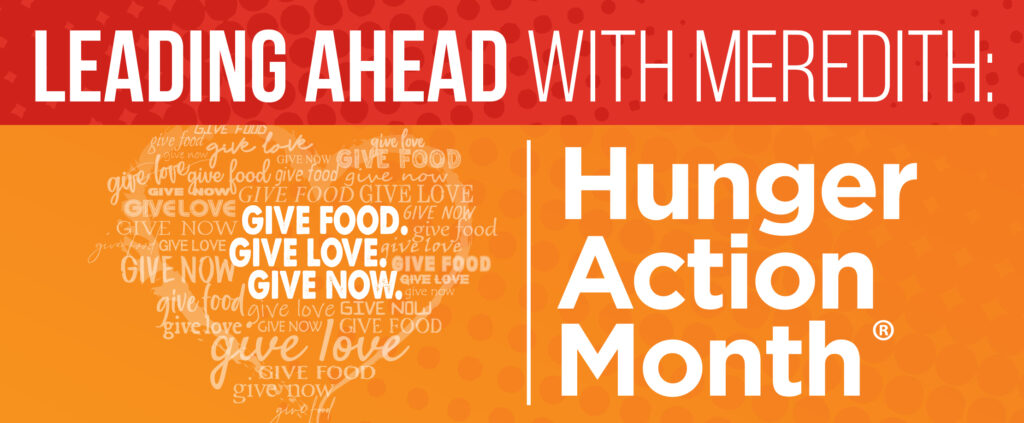This photo demonstrates one of the many differences between the St. Louis Area Foodbank, a 92,000 square foot warehouse and a food pantry as picture in the inset (photo of Matthew 25 Food Pantry) / Photos by Bethany Prange
“How many people does the Foodbank serve each week at your facility?”
It’s a question that everyone asks when touring the St. Louis Area Foodbank.
The quick and literal answer would be a startling zero. But dig a little deeper, and the number jumps up to 57,100.
That ridiculous discrepancy will make complete sense by the end of this post.
When I think about how to best describe the relationship between the St. Louis Area Foodbank and a food pantry, I reflect on something I learned back in one of my high school science classes.
Food banks and food pantries are very similar, but also very different. That fact reminds me of symbiosis. (Here comes the nerd alert.)
Symbiosis is the relationship between two organisms that live in intimate contact with each other. In reference to the Foodbank and food pantries, I’m thinking of mutualism – where both organisms benefit from the symbiotic relationship because they rely on each other for survival.
In this symbiotic relationship, the Foodbank is definitely the bigger of the two organisms, but we still rely on the smaller organism (the food pantries) to achieve our goals.
In non-science nerd terms, the St. Louis Area Foodbank is a distributor. We collect and store 25 million pounds of food a year, then distribute it out to the smaller food pantries, who in turn, hand it out to families in need.
When I said earlier that the Foodbank serves zero individuals a week from our facility, that’s literally true, because we don’t serve clients directly from our location.
We’re a 94,000-square-foot warehouse space out in Bridgeton, Mo. If we tried to feed 57,100 people a week all from this one location, we’d have mayhem on our hands.
Therefore, if you had a situation, or situations, in your life that caused you to need food assistance, you would not come to the Foodbank’s Bridgeton warehouse. You would most likely visit a food pantry in your community.
A food pantry acts as the front line in the war on hunger. According to Feeding America’s “Map the Meal Gap” study, 514,600 people living in the bi-state region are in need of food assistance. The pantries take product that they receive from the Foodbank and other sources and then distribute it out to those in need.
The majority of food pantries are run by the people in your community that want to help other people out of the goodness of their hearts.
According to the 2010 Hunger in America Study, commissioned by Feeding America, 55 percent of the pantries that get product from the Foodbank operate with no paid staff.
To put that in relative terms, think about your favorite restaurant. Now imagine that you are running that restaurant. On a busy Friday night, 200 hungry people show up to your restaurant wanting to eat. In that crowd of 200 people there are all types – the grateful, the rude and everything in between.
All these people need to be taken care of…but you and your entire staff run this restaurant as volunteers. Your customers need to be served, but you’ve been so busy working your paying job that you haven’t had time to go out and find food to feed them.
That’s where the Foodbank comes in.
The St. Louis Area Foodbank uses its resources, space and staff to bring food into the region and then distribute it out to those directly serving those in need.
The sheer volume of the food required is astounding. Most visitors to our facility are shocked by the size of our warehouse space, because until you’ve seen rows and rows of canned corn, apple juice and breakfast cereal (along with hundreds of other items), you probably don’t recognize the magnitude of the problem.
Until you’ve seen two million pounds of food that will be out the door within weeks of getting it in, you can’t really understand how big the issue of hunger has become.
We get food in from a number of different sources, including the USDA, local and national manufacturers, farmers, local retail stores, and community food drives. Then we distribute the food to our partner agencies, the majority of which are food pantries.
The Foodbank needs the pantries to distribute the food to those in need directly from their facilities, while treating clients with the respect they deserve. The food pantries need the Foodbank to go out and find the food and bring it into the bi-state region.
One could not operate successfully without the other. The true definition of a symbiotic relationship.
The difference between the St. Louis Area Foodbank and a food pantry isn’t rocket science, it’s just high school biology.



